Cheap Log Cabin Foundations: Choosing the Best Base
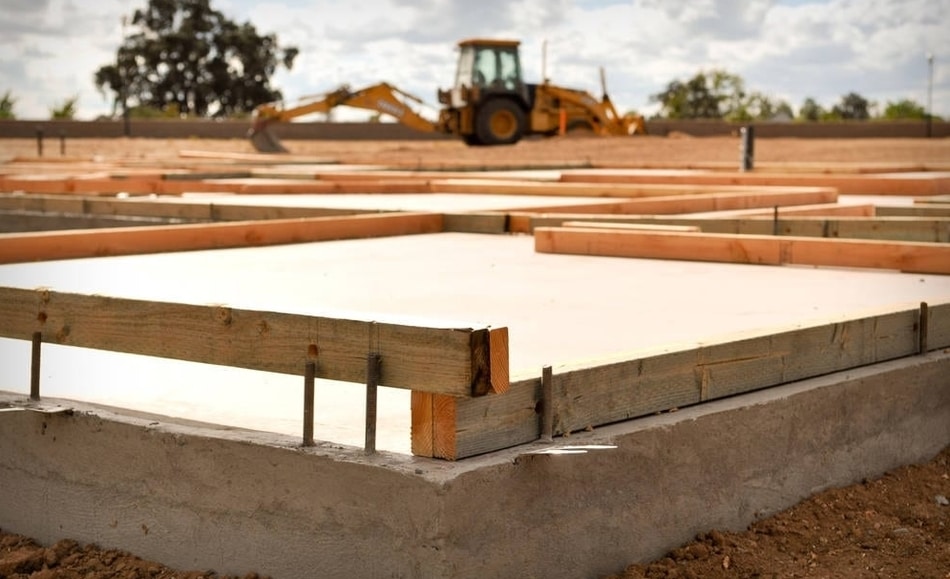
Choosing the right foundation for a log cabin is a very important step. Like everything else in life, a quality foundation is what makes a good house. In the case of log cabins, the cabin base’s main task is to shift and disperse the weight of the cabin equally into the ground.
A good and quality foundation provides stability and durability to the structure. Since log cabin construction is heavier than a regular shed, it needs to have a different, more complex foundation. To find out more about this topic and how to choose a cheap foundation, continue to read this article.
Before we begin, the first thing to understand is that a good foundation needs to have good strength and stability. It will protect your log cabin from:
- Subsidence – This is present when soil is sliding away under your cabin over a longer period of time and can cause the foundation to become asymmetrical or even crumble if it’s not well built. A strong foundation stops that from happening.
- Settlement – This is when the cabin’s weight and load push the structure into the ground in the earlier stages of ownership, causing it to sink into the ground if the base is poorly built. Strong foundations stop that from happening.
In the following chapters, you can read more about different foundation types, when to use each one and how to construct them.
Table of Contents
Quick Guide On How To Select a Foundation Type
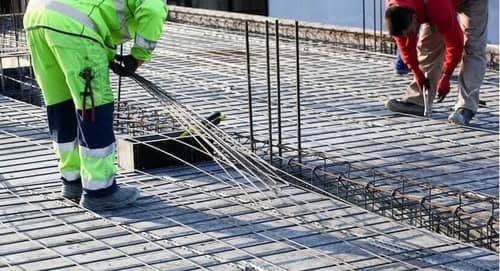
Note! The fact that your cabin’s foundation isn’t visible when it’s completed doesn’t mean it’s not important!
The foundation you choose for your cabin will be determined by the following factors:
- The rock and soil type your property will be lying on (Rock, Gravel, Chalk, Sand, Peat, or Clay)
- Log Cabin size
- Position of water flows on the ground
- Gravel and rock textures
- Drainage system layout
- Topography-The foundation of the site
- Budget for construction
Keep in mind to over-engineer your base during the design phase of the project. Many people tend to complicate things too much because of how complex foundations usually are for other types of buildings. Those types of foundations are typically made of brick and mortar, which is more expensive and complex than log cabin wood frame structures.
For traditional log cabin dwellings, deeper foundations such as: pillars, reinforced broad strips, and piles aren’t usually necessary either. As a result of overcomplicating, a cabin construction project may waste a lot of materials which is other than a needless expense, and bad for the environment. This article will focus on 3 types of shallow foundations that are great for cabin building: pad, strip, and raft foundations.
1. Raft/Concrete Foundation
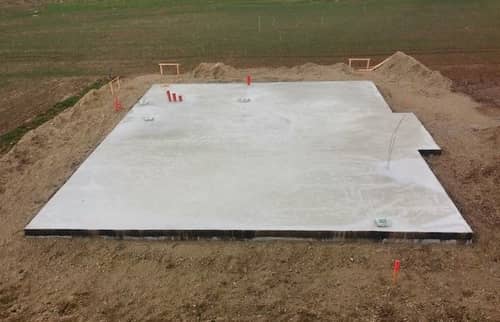
A raft foundation is a basic foundation system that involves laying a raft of concrete beneath your complete log home. The raft foundation base is utilized to distribute the cabin’s weight throughout the whole structure’s floor surface.
Because it involves fewer crude materials and digging, a raft foundation is less expensive and faster to build than a strip foundation. To stop the cabin from moving with the ground, raft foundations are often constructed on solid materials, such as broken bricks or stone, which do not absorb water.
When This Technique Should Be Used?
- Raft foundations are often constructed on a softer substrate (for example, soft clay) to assist disperse the weight load of the lodge. This works due to the reduced bearing capacity of softer grounds.
- Typically, raft foundations are ideal for lousy ground conditions on which standard bases (such as strip foundations) would fail to adequately transmit the cabin’s weight load.
Example:
The calculation for the amount of concrete required for the raft foundation:
(Length x Width x Depth) x 1.3
For example, a 900FT2 cabin.
The calculation would look like this:
(9.15 x 9.15 x 0.1 meter) 8.36 m3 * 1.3 m3 = 10.89 m3
The process of building a concrete base foundation in five steps:
- First, use hooks called pegs to outline the cabin’s perimeter on all four sides. When laying down your base structure, it’s smart to add 6 inches to the outer perimeter of your cabin.
Note! For example, a 30FT × 30FT cabin requires a foundation of 31FT x 31FT.
After you’ve identified all four edges, use Pythagoras’ theorem to ensure the base of the cabin is square-shaped. The fastest way, even more, efficient than Pythagoras’ theorem, is by measuring diagonals. If both of them are the same length, the foundation is square.
- Dig to a depth of 80cm x 10cm into the material inside your pegs. Fill this space with a layer of concrete, then compress it using a plate compactor. You can use rebars, which are steel spacers, to add strength to the whole structure. This building is commonly utilized in strip foundations or in larger cabins.
- Next, you should build a wooden prefabrication cover to go around the perimeter of the foundation to keep the concrete in.
- Use the appropriate mix strength, explained below in this subsection, to combine and pour the concrete. While mixing the concrete, avoid adding large amounts of water at once, as this will weaken the mixture.
Mix strength:
Strength C30 is recommended by Building Standards (BS-5328). It consists of 1 part cement, 2 parts sand, and 3 parts hardcore.
Just so you can count how much time this will take and how many people you need, you can mix approximately around 1 m3 per day. Concrete mixing and wheelbarrowing can be strenuous on the body. Our recommendation is to use ready-mix concrete if one man needs to produce more than 2m3 per day. That’s important information to consider. - It’s best to mix those by using a piece of wood and level the concrete by laying each end on the formwork.
Tip To Get Stronger Foundation
Rather than using formwork and timber to cover the concrete foundation, you can utilize blockwork for a sturdy foundation. This is a popular approach for giving the proper foundation with extra stiffness that can take a heavier cabin.
Related Article: Log Cabin Fire (Everything You Need to Know)
2. Strip Foundation Base
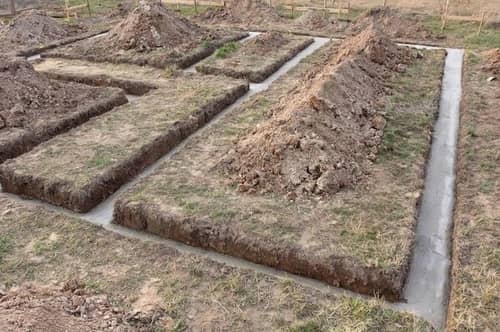
The Strip foundation is the most frequent foundation technique that is used for classic brick & mortar structures. This method is a continuous line of concrete beneath the weight-bearing lumber in the lodge. This strip then serves as a leveling platform on which you may place your logs. When your cabin’s location has a firm soil basis and no indication of stagnant water or waterlogging, a strip foundation can be used. The strip base should have a firm dirt base at the foundation.
When This Technique Should Be Used?
- Only meant for log cabins that are built on dry land with no standing water.
- Strip foundations should be used to sustain single-story cabins.
- This method works for two-story dwellings only if the strip foundation is installed deeper.
Note! A leveled and dry site is the starting point for any base foundation.
- If your site isn’t leveled, you’ll need extra shuttering and concrete to finish it, which will add to the expense and still not completely guarantee success in building a strong base.
- If the location isn’t completely dry, the concrete will not dry correctly.
How to build a stable concrete foundation?
- Start by identifying the whole weight-bearing logs using your log home’s floor plan layout. Draw out where these logs will lie flat using pegs and twine.
- Dig up all of the mud inside your anchors to a depth of 60cm and a width of 30cm once you’ve defined the strip structure. The 30cm width ensures that those 12-inch logs could fit snugly on the base.
Note! Make sure that the trench’s horizontal and vertical borders are level.
- If you want, you can place concrete separators and rods in the trench’s bottom and/or a steel reinforcing grid that adds to the foundation’s resilience.
- Combine ingredients and pour the concrete at about a 15cm thickness, using the same processes as for the raft foundation.
Note! Keep an eye on the weather! It’s important that temperatures do not reach extremes. Not too high nor too low of temperatures. That’s because extreme conditions influence the concrete drying process in a bad way. If it is too hot (above 95 Fahrenheit), then the cement mix will settle faster than acceptable and become weaker. On the other hand, if the temperature is too low, which is below 35 degrees Fahrenheit, the water in the concrete mix can easily freeze and crack, leading to the mixture failing to dry correctly.
- When the concrete has been set, create a board up to the finished ground floor level utilizing engineering blocks.
Best Variations For a Strip Foundation
A trench fill base foundation is a common version of the strip foundation. It’s both deeper and thinner than a strip foundation. The trench is filled entirely with concrete, rather than a mix of concrete and engineered bricks. Trench fill is ordinarily employed for clay soil grounds that necessitate a deeper trench.
Related Article: Differences Between Log Home And Log Cabin
3. Pad Foundation
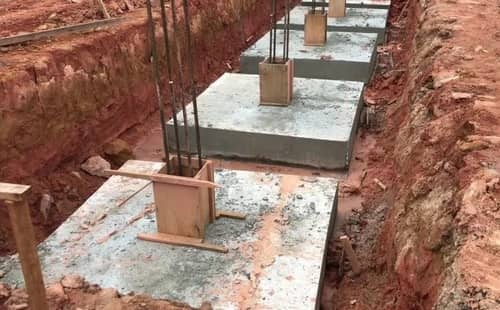
A Pad foundation carries your cabin’s single-point load. Each of your log cabin’s four corners usually rests on a concrete pad foundation. Thus each of the four concrete pads is below one of the log cabin’s corners. Pad foundations are generally square and built of rebar-reinforced concrete, often called “steel members.”
With the usage of pad foundations, the burden is subsequently transferred from your wood cabin into the surrounding and underlying ground via the pad. The diameter of your pad foundation may be extended to spread a load of your cabin across a larger area similar to the raft foundation explained above.
Note!
Pad foundation is the cheapest solution available on the market. They are also known as ‘pad-stone foundations’ and ‘concrete piers’, so do not get confused if you see those names. They mean the same thing.
When this technique should be used?
- When you have an existing firm soil basis for your cabin’s site, a pad foundation is the best solution.
The installation of a pad foundation is quite similar to that of a raft, it’s interesting knowledge about how raft foundations are built. The distinction is that instead of digging and concreting the whole foundation, you limit yourself to tinier concrete blocks.
Things to Remember:
- Foundation’s purpose is to provide strength and stability. That’s why a proper foundation protects from hazards such as subsidence and settlement.
- When you go through the design phase of the construction process, be sure not to over-engineer your foundation.
- If you’re new to building, a great book to read is Roy C Hudley’s Building and Construction Handbook to ensure you know how to calculate the mass of your cabin’s lumber, contact pressure, and base requirements correctly.
Here is a great video about the log cabin foundation that you can see:
Be sure to also read 7 Essential Log Cabin Tools Required to Build a Log Cabin.
FAQ: People Also Ask
What is the cheapest foundation for a cabin?
The cheapest log cabin foundations are the ‘pad-stone foundations’ also referred to as the ‘concrete piers’.
What foundation is needed for a log cabin?
The greatest alternative for a low-cost, high-quality foundation is a wood frame and solid block concrete foundation. It’s half the price of the commonly used concrete slab. This sort of foundation is particularly common for log cabins since they may be built at any location, even those with little or no access to them.
What is the best base for a log cabin?
The ideal log cabin foundation is a flat and level concrete foundation. This works in most cases, especially if you already have a paved or decked area where you want to put your cabin. The most crucial element of any base is that it has to be flat, square, and completely level in order to serve its purpose properly. Additionally, run-off in any form isn’t needed.
Final Thoughts
The main purpose of this article about cabin bases was to be both helpful and useful. We hope that we achieved that and that you are now able to choose the best foundation for your log cabin home. To prevent making any mistakes in the choice of base, choice of material, location, or anything else, examine the finest recommendations and guidance summarized above and, if feasible, engage a building professional to validate your foundation decisions.


Your article helped me a lot, is there any more related content? Thanks! https://accounts.binance.com/it/register?ref=53551167
Thanks for sharing. I read many of your blog posts, cool, your blog is very good.
Thanks for sharing. I read many of your blog posts, cool, your blog is very good.
Thank you for your sharing. I am worried that I lack creative ideas. It is your article that makes me full of hope. Thank you. But, I have a question, can you help me?
Thank you for your sharing. I am worried that I lack creative ideas. It is your article that makes me full of hope. Thank you. But, I have a question, can you help me?